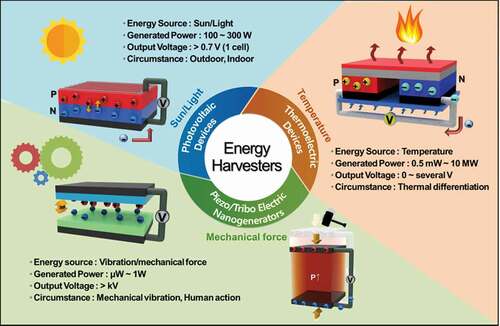A nanogenerator, as an energy harvester, is known to generate electricity by using low-frequency physical or thermal movement. The nanogenerator is usually classified into three categories of piezo-, tribo-, and pyroelectric devices, which correspond to the energy conversion mechanisms of stress or strain, contact electrification, and temperature fluctuation, respectively, as shown in . Regardless of their type, nanogenerators can align with all the requirements of cost-effectiveness, flexibility, hybridity, and compactness for practical applications.
Very recently, wearable devices for human interactive applications have received considerable attention from the scientists and engineers, owing to the growing demands in terms of self-charging, monitoring, and battery miniaturization. In particular, self-powered devices that harvest energy from the environment such as human movement are immerging as a hot topic because the energy obtained from human movements can be applied directly to wearable electric textiles for daily activities. These outcomes aim to provide substantial longer-term benefits once the self-charging energy source technology has matured and is commercially produced, such as in powering the next generation portable and wearable electronics, including health monitoring devices.
However, there are still controversial issues in terms of high voltage and relatively low current output. Besides, even if they need to generate continuous or high-frequency power to be used, a nanogenerator can only make instantaneous or pulsed power (i.e., alternating current) when it receives mechanical energy as the input. To overcome this critical problem in existing nanogenerator technology, the combination of energy storage devices and various types of nanogenerators is required for various electronic systems.
In the case of patchable nanodevices, power requirements that depend on the module or type could range from 1 to 100 μW per hour. Such a demand could be met with smart nanogenerators without energy storage systems. Ongoing research efforts are focused on the development of wearables that can be easily integrated into smartwatch, band, clothing, skin patches, etc.
Our special issue in advanced nanogenerators addresses the-state-of-the-art nanogenerators reflecting the above technical issues. This issue consists of a number of papers, including perspective and review articles.
References
- Han SA, Lee J, Lin J, et al. Piezo/triboelectric nanogenerators based on 2-dimensional layered structure materials. Nano Energy. 2019;57:680–691.
- Kim J, Lee JH, Lee J, et al. Research Update: hybrid energy devices combining nanogenerators and energy storage systems for self-charging capability. APL Mater. 2017;5:073804.
- Lee JH, Kim J, Kim TY, et al. All-in-one energy harvesting and storage devices. J Mater Chem A. 2016;4:7983–7999.

